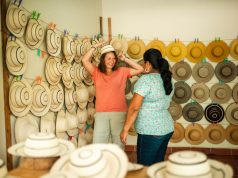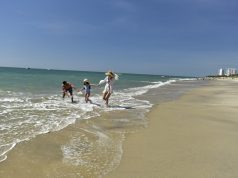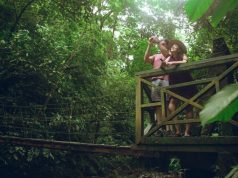Indigenous History, Culture and Lots of Nature to Enjoy
Due to its proximity to Panamá City capital as well as to the Pacific Riviera, Cocle province offers a diversity of landscapes that vary between mountains, beaches and nature reserves. You can go from a cool micro weather system to a very hot one in the same day. Because of this and more “Coclé has it all”.
El Caño Archaeological Park
This 8-hectare park has a museum inaugurated in 1979. However, this archaeological treasure was discovered in 1926 by the North American Hyatt Verrill, who excavated the area commissioned by the “Heye Foundation”. In the place there were samples of tombs and basalt pieces of a pre-Columbian civilization that lived between 700 and 1,000 AD. Other pieces carved with faces, columns and megaliths (800 AD) were sent to the Museum of the American Indian in New York.
Activities:
Visit “El Caño Archaeological Park Museum” and discover a complete tomb where bones, ceramics, gold and stones were founded in 1979. It is also possible to see an excavation led by archaeologist Julia Mayo (2000), where a wide extension of cemeteries were found.
Curiosities:
Artifacts have been discovered that speak of a complex system and iconography, sophisticated goldsmithing technology, and an elaborate social hierarchy.
Where to eat and stay:
On this site there are no places to eat or hotels, but in Nata and surrounding areas offer typical Panamanian dishes and international food, as well as places to spend the night.
How to get:
Located 160 kilometers from Panama City, it is a two and a half hour drive. Also, from the Albrook bus terminal taking the Panama – Nata route and then take a transport to the Community of El Caño, and then walk 2 km passing by the San Lorenzo Church, since there is no direct transport.

Valle de Anton
Mountain town with a micro weather system whose name comes from “El Valle de Anton Caldera”. This Valley is located inside a crater or caldera of an extinct volcano (extravolcano), 600 meters above sea level. At the top of “La India Dormida”, “Cerro La Cruz” or “Cerro La Silla” where you will be able to see the formation of this crater.

Activities:
It is possible to learn about the ecology of this destination by visiting “El Níspero” zoo, study centers such as the serpentarium or the butterfly garden. For those who seek ecotourism there are hiking, ascents to mountains, hills, walks to rivers and waterfalls.
A highly recommended point is the reserve where Chorro “El Macho” is located on the outskirts of the town. They have marked trails, a natural pool and hanging bridges. This trail is open every day from 8:00 am – 5:00 pm. Admission to the gazebo and trails is $.5.00, the pool is an additional $5.00. If you want to enjoy from 100 feet high, you should ask about the “Zip Line” options.

Where to eat:
In this paradise you can enjoy a wide variety of gastronomy that goes from cafeterias, inns and international food such as Italian, Chinese, Peruvian, Mexican, Spanish, Colombian and Greek. Of course, typical treats such as cocada and artisan pastry is a mandatory stop in the different cafes and bakeries in the town.
Curiosities:
In El Valle there is a rock called the Painted Stone, a huge petroglyph with engravings made by the indigenous people hundreds of years ago and that until today no one has been able to decipher it.
How to get:
It is possible to get to El Valle by bus. From Albrook Bus Terminal, the ticket costs $4.25 dollars and the buses leave every 30 minutes from Platform 48. The last direct bus back to Panama City from the Valley leaves around 3: 30 p.m.
La Pintada
This town has a very curious name. It is said that there was a thatch house of a merchant that was known as “La Casa Pintada” for its bright colors. Over time this phrase was shortened to “La Pintada”. It is also known as “The Cradle of the Pintado Hat” which is part of the clothing of Panamanian typical costume.
Activities:
In this town it is possible to know the main dances that are practiced in La Pintada such as: “El Tamborito” “La Cumbia” and “El Topon” with more than 250 years. Every December 25 you can participate in the pilgrimage of the Virgin “La Pascualita” and “El Niño Dios”.
Where to eat:
This picturesque town, although it is very traditional culturally, has local and international culinary proposals as well.
Curiosities:
The Pintao hat is a UNESCO intangible heritage of humanity.
How to get:
From Panama City it can be reached by car in 2 hours 45 minutes, also taking a bus from Penonome City it is possible to reach La Pintada.
El Salado de Aguadulce
The salt flat is a plain of hundreds of hectares of land transformed into an albino background, it is possible to see white pyramids of salt.
Activities:
It is recommended to visit the salt flat from 4:00 am, when they start their work, especially between the months of January and April, when tons of salt are collected. You can also go to “La Caleta” viewpoint , “El Embarcadero”, beaches “El Rompio” and “El Salao”.
It is also important to visit the Stella Sierra Museum (Museum of Salt and Sugar), where the history of the salt and sugar workers from pre-Columbian times is kept. Hours: Tuesday to Friday from 8:00 a.m. to 4:00 p.m. Saturdays from 8:00 a.m. – 1:00 p.m. Sundays by appointment and admission is free.
Where to eat:
The gastronomic offer is located in Playa El Salao where there are restaurants that offer seafood, fish, typical local and international food.
Where to stay:
As El Salado is located on the outskirts of Aguadulce, this city has a wide range of hotels for all tastes and budgets.
How to get:
El Salado is located three hours from the capital city by the Inter-American Highway (197 km). When you get to Aguadulce you must go to “Los Méndez” Park, drive along “El Salado” street until you reach “Las Salinas” on “El Salado” beach (15 minutes). It is possible to go by bus, it costs $1.00, between 6:00 am – 5:00 pm. A taxi from Aguadulce can cost $5.00.
El Cope
198 kilometers from Panama City is El Cope in the El Harino vilage at La Pintada, a forest park next to the central mountain range. In this reserve there are rivers such as: Belencillo, Tigrero (Bajo Grande), Zapillito and Zapillo. Also “The General Division Omar Torrijos Herrera National Park”.
Activities:
In this sector there are more than 30 places to visit such as “Chorro Alto” and “Los Chorros Gil”, “La Cascada Tenilda” 15 minutes away, the Agrotourism Farms “La Leyenda” and “El Eden”, the “Chorro Grande” (30 minutes) and the “Chorro Las Yayas” with three waterfalls. For the intrepid there is “El Gran Tife”, an imposing waterfall inside the Forest Park General of Division Omar Torrijos Herrera which will arrive between 10 am and 2 pm.
Where to eat:
Being a nature reserve, the offer is somewhat limited, however, it is possible to find family restaurants such as Terraza de El Cope and Fonda Las Chelitas.
Where to stay:
There are no hotels in Cope, however there is a wide range of houses that are rented through the Airbnb application, and have all the comforts to enjoy a stay surrounded by nature.
How to get:
From the Albrook Transport Terminal, you can take a bus on the El Cope route, the trip takes about 3 hours. In your own car, you drive along the Pan-American Highway for 176 km way to Ola in El Caño, where you must continue for 24.4 km until you reach El Cope.









